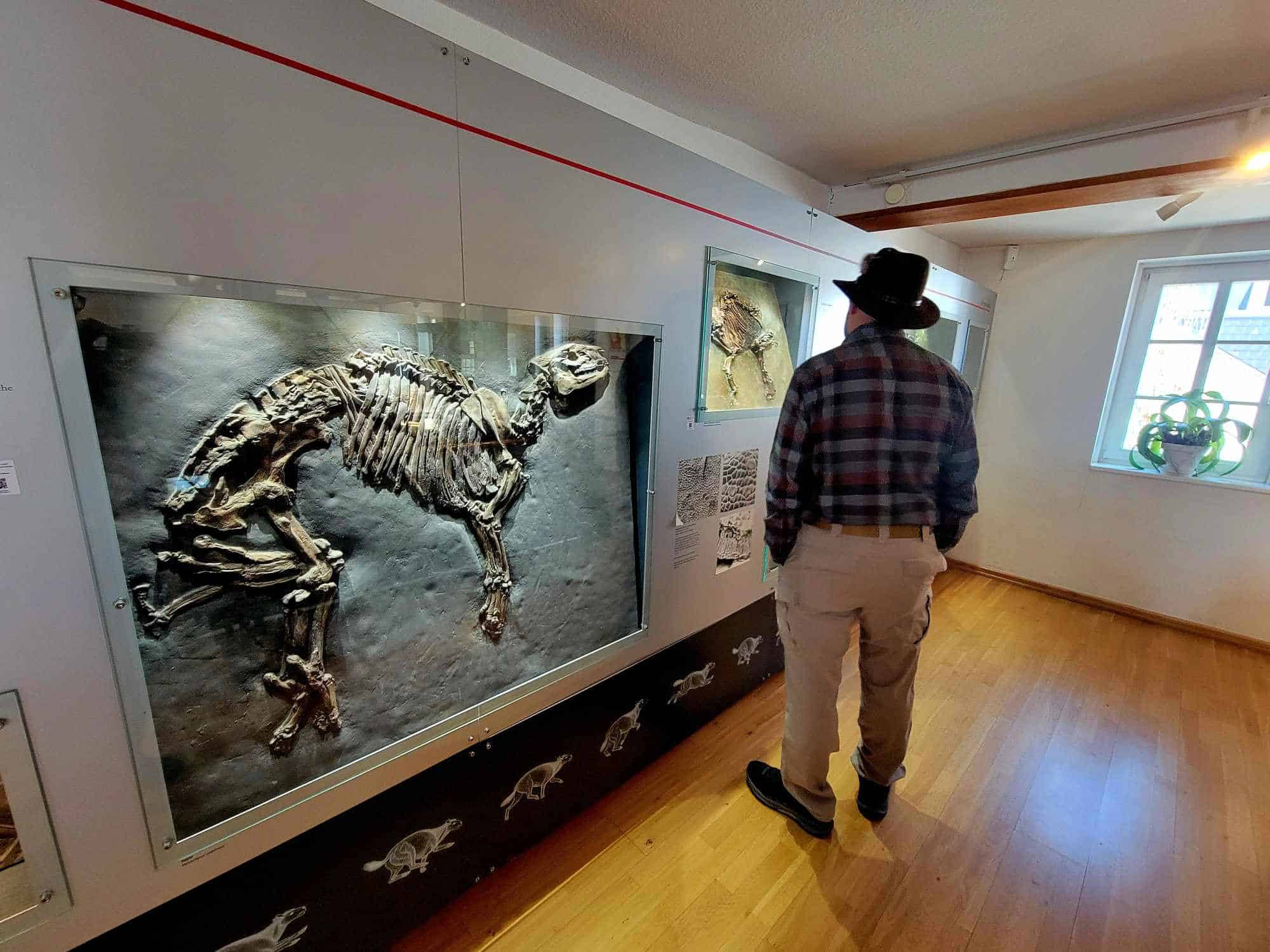Want to see the best Messel Fossils in just one day?
Germany’s famous Messel Fossil Site near Darmstadt is just the beginning—did you know the most impressive fossils are spread across three different locations? In this guide, you’ll get a smart one-day itinerary to hit all the top spots, plus where to grab a delicious bite nearby.
When I first tried to visit the Messel Fossil Site, I left feeling like I missed half the experience. It actually took me two separate trips to figure out how to see all the key fossil displays—and now I’ve made it simple for you. Let’s make the most of your visit!
🦇 What is the Messel Fossil Pit?

The Messel Fossil Pit (Grube Messel) is a UNESCO World Heritage Site and one of the most significant fossil deposits on the planet! This former oil shale quarry tucked away in an unassuming little town near Darmstadt might look like nothing more than a random hole in the ground. The truth is, it’s a veritable time capsule from 48 million years ago—an Eocene-era treasure trove of fossils that continues to upend and rewrite what we know about the evolution of mammals, birds, reptiles, and even insects!
You will find no dinosaurs here, but trust us, this place is absolute magic for fossil lovers of all ages.
⛏️🪨 Why is the Messel Fossil Pit Important?
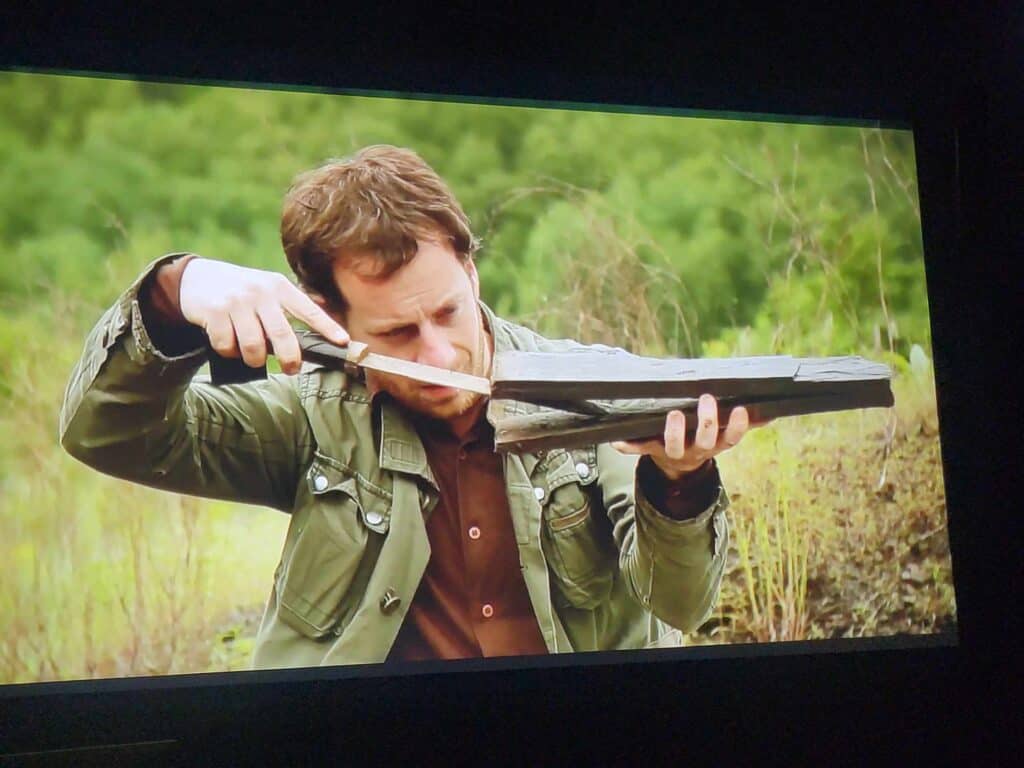
The Messel Fossil Pit is a paleontological goldmine. It’s not just the number of fossils that makes it extraordinary—it’s the mind-blowing quality of their preservation. Many fossils found here are so well-preserved that soft tissues, fur, feathers, spines, scales, and even stomach contents remain intact! That means scientists don’t just get the bones—they get an intimate look at how these ancient creatures lived and died.
The Messel Fossil site has yielded:
- The earliest known relatives of modern horses (the dainty Propalaeotherium) which are the stars of the show!
- Exceptionally preserved primates like Darwinius masillae (nicknamed “Ida”) – an ancient lemur!
- Giant flightless birds whose skeletons are almost as tall as an adult human, and a little freaky!
- Ancient crocodiles with every detail of their intricate bones preserved
- Turtles and insects with their color patterns still visible
In short, Messel has helped shape our understanding of post-dinosaur life and the explosion of mammalian evolution that followed it.
🦴🕰️ What is the Age of the Messel Fossil Pit?

The fossils in the Messel Pit date back about 48 million years to the middle of the Eocene epoch—a time when Central Europe was a steamy, tropical rainforest. The pit itself was once a maar lake, which was formed by a volcanic explosion!
Over time, the lakebed filled with organic material, perfectly preserving the animals and plants that fell in. All these organisms that ended up at the bottom of the lake became locked in an oxygen-deprived, bacteria-resistant environment that protected their remains for nearly 50 million years!
🔎🛢 A Brief History of the Messel Fossil Pit
The Messel site wasn’t always a place of scientific wonder. It was first mined for oil shale in the late 1800s, and for decades, fossils were discovered there mostly by accident. And who knows how many incredible ones were ground up to make lubricants and solvents of various kinds. I can’t think about it too long or I get depressed!
In the 1970s, to add insult to injury, the pit was slated to become a landfill, but a global campaign by scientists, conservationists, and some good old boots-on-the-ground activism led to its eventual protection!
In 1995, UNESCO recognized the Messel Fossil Pit as a World Heritage Site, cementing its place in natural history, and as a miraculous resource for the public to come and see its wonders.
⛏️🪨🦴 Can You Dig for Fossils at the Messel Pit?
Unfortunately, no. Today, excavation is strictly controlled and carried out only by scientists, but this doesn’t mean you can’t get up close and personal with the area, and most importantly with the fossils themselves.
🦴 👀 Must-Visit Sites to See the Best Messel Fossils
There are three key areas located in Messel, and Darmstadt where you can see the fossils. Each is slightly different, but visiting all three will give you the best overview of the incredible paleontological riches that this area has given the world.
Here’s how to visit the Messel Fossil Pit, Messel Village Museum, and the Hessisches Landesmuseum in one perfect fossil-filled day. At the end you’ll find a suggested itinerary to make this a day trip.
1. Messel Fossil Pit Visitor Center (Besucherzentrum Grube Messel)
Roßdörfer Str. 108, 64409 Messel

This sleek, modern visitor center sits right next to the famous fossil pit itself, and is the best place to start your Messel fossil journey.
You can’t visit the pit on your own, but a guided tour will bring you there, or you can view it from the observation deck on the back of the Visitor Center. It doesn’t look like much, but it’s cool to see the actual spot where these amazing fossils originated.
🔍 What Makes It Special
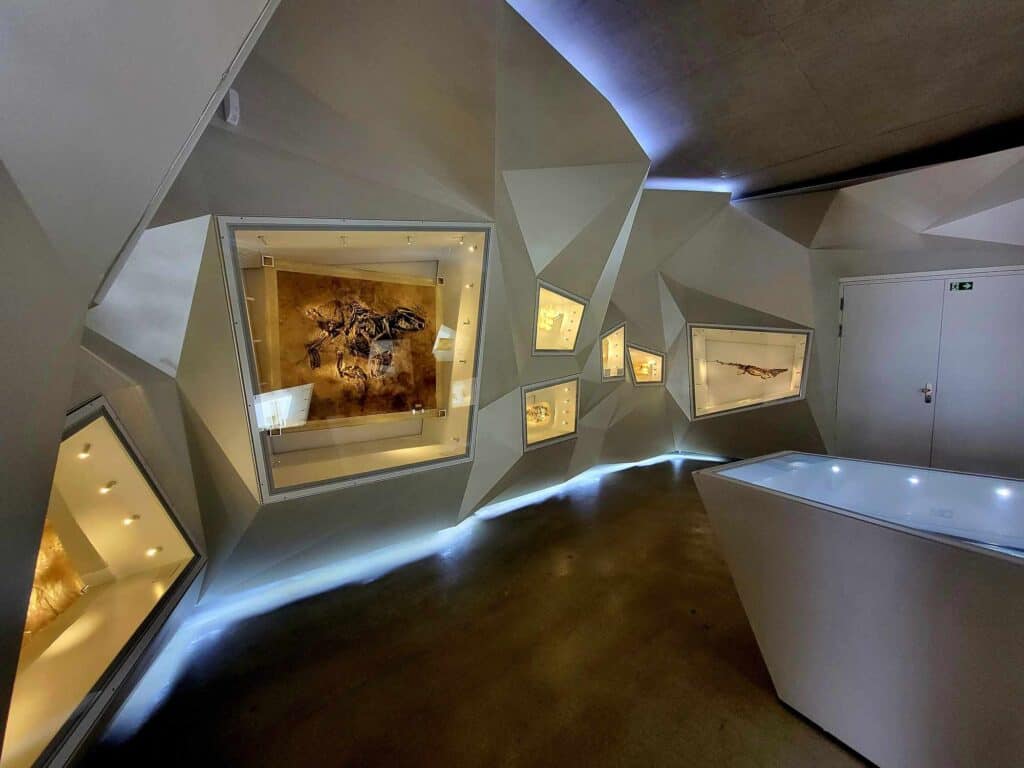
- The Visitor Center offers guided tours into the fossil pit complete with explanations from trained guides. English tours are only available on the first Friday of the month at 3:30pm so you’ll have to plan ahead.
- Exhibits at the Visitor Center include actual fossils from the pit and detailed reconstructions of Eocene-era flora and fauna.
- Great for families and science geeks alike. Touchscreen displays, interactive stations, and life-size models make it immersive and fun.
- If Geology is your thing, you’ll love the core samples, and detailed explanations about the volcanic activity in the area, the formation of the Messel lake, and the processes by which the fossils were preserved.
- There’s a great short film in German with English subtitles that tells the whole story of the Messel Fossil Pit from first discovery until its preservation as a UNESCO World Heritage Site. Don’t skip it!
🦴 Iconic Fossils on Display
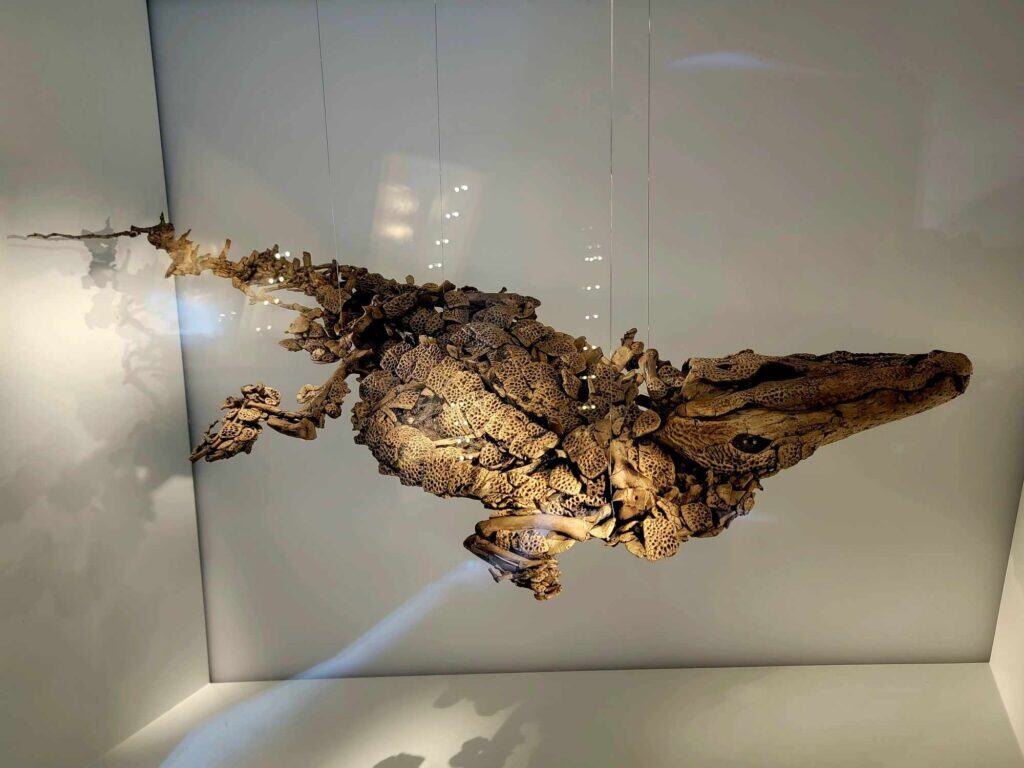

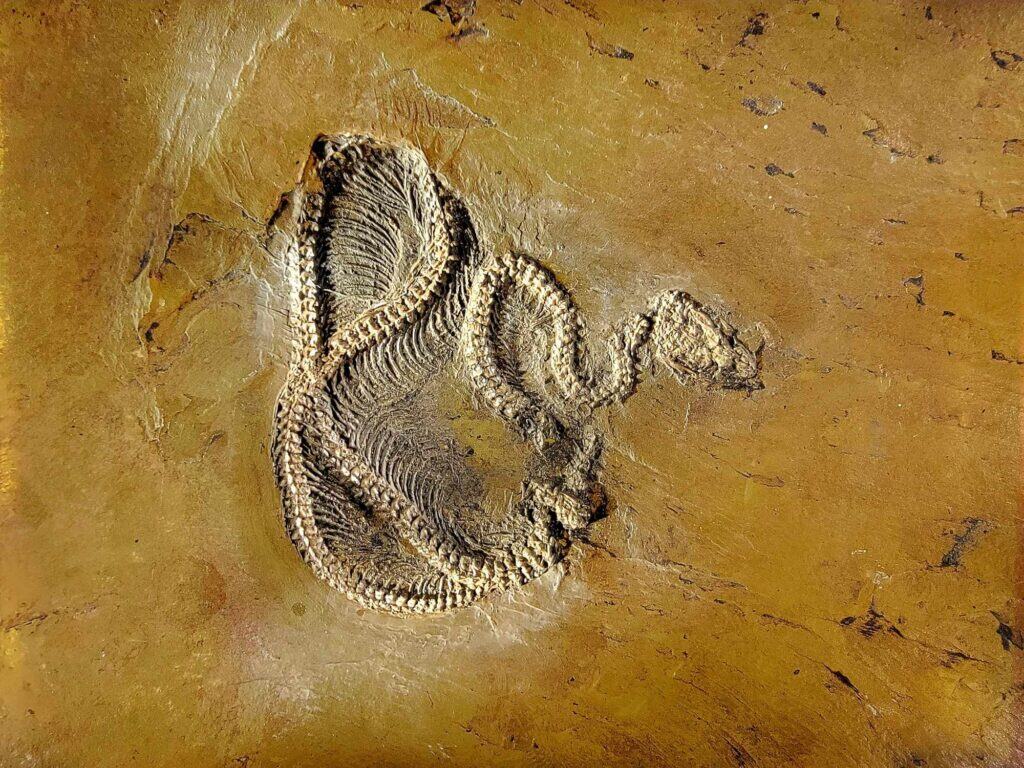
- Propalaeotherium, the tiny forest horse
- My favorite – a jaw-dropping full crocodile skeleton
- Stunningly preserved bats, insects, and plants
ℹ️ Visitor Information
- Admission: €7 adults, €5 children (family tickets available)
- Hours: Tuesday to Sunday, 10:00 AM to 5:00 PM (closed Mondays)
- Website: grube-messel.de
- Food: There is a small café for quick bites and beverages
- Parking: There is a large free parking lot on site
💡 Pro Tip: Book your tour well in advance! They fill up fast, especially in summer and school holidays.
Also, don’t go into the immersive exhibit where you feel like you’re drilling down into the center of the earth if you have issues with vertigo! (Ask me how I know…)
2. Messel Museum (Fossilien unt Heimatmuseum in the Village of Messel)

Your second stop should be here! A lesser-known hidden gem, this small museum in an old schoolhouse in the sleepy village of Messel is completely free and run by local volunteers. It’s great for a quiet, up-close look at fossils without the crowds.
When we were there, there was a cute display of dioramas made by local school children. It’s really charming and it’s easy to forget you’re not only in a little 2-room schoolhouse, you’re in a world-class fossil museum!
🔍 What Makes It Special
- Free admission, local charm, and passionate staff (There is a donation box at the front desk if you wish to donate)
- Diorama of the area and its flora and fauna
- Lots of local history tied to the mining era and early fossil finds
🦴 Iconic Fossils on Display
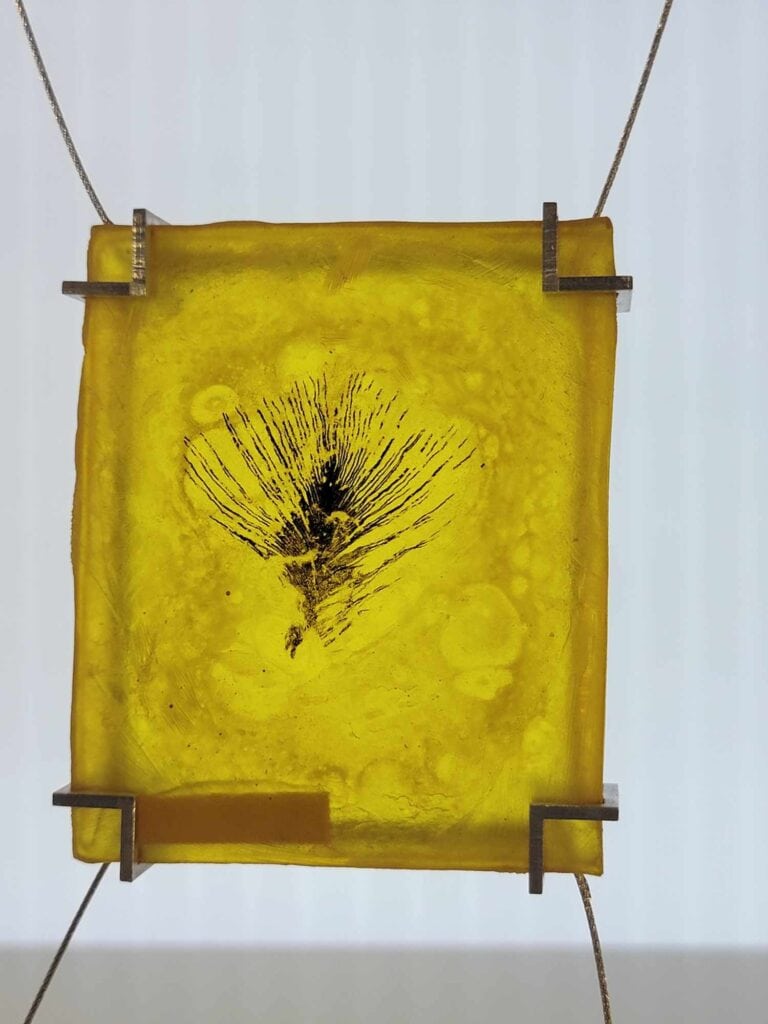
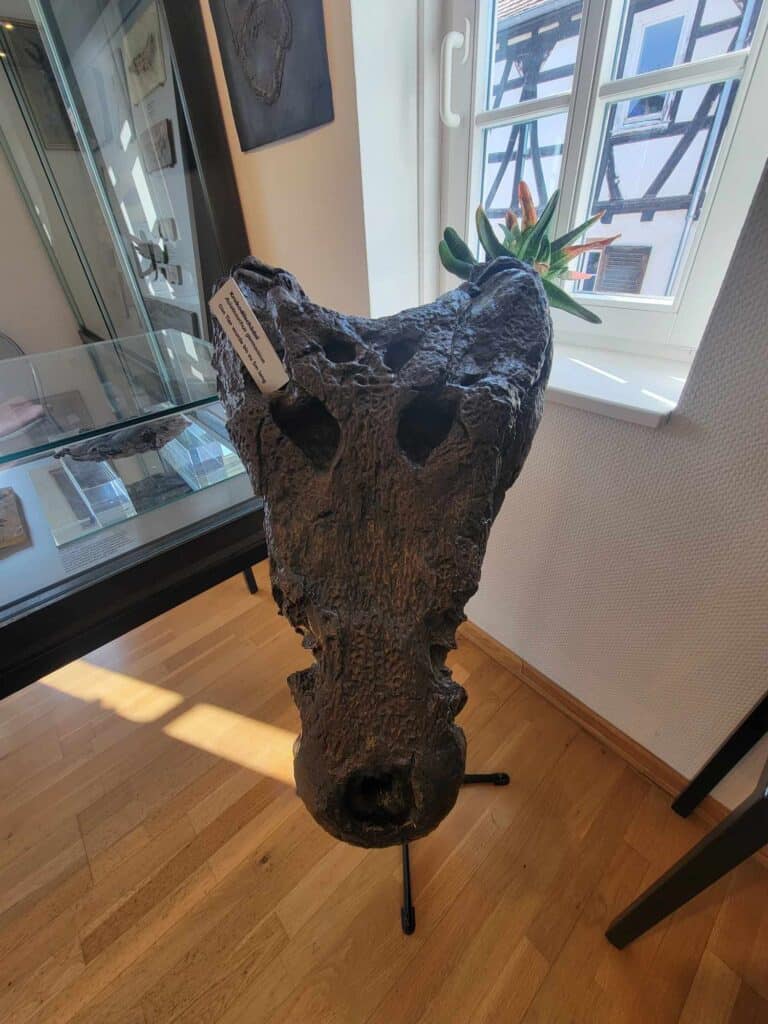
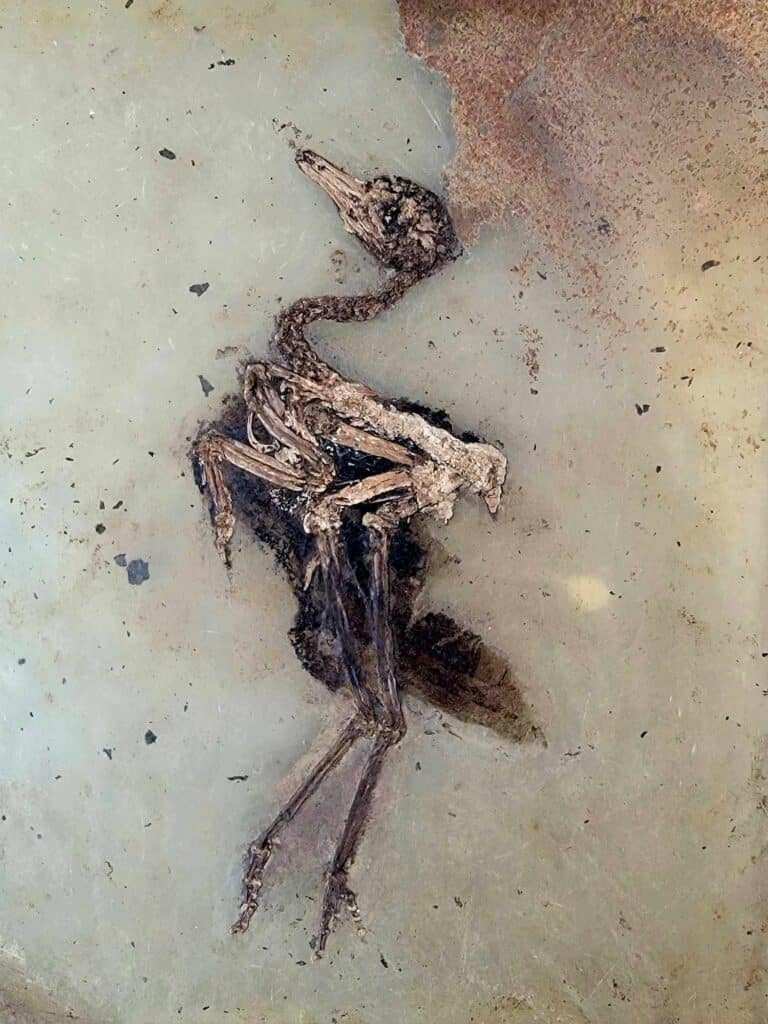
- Replica of Ida the famous lemur that started it all
- A huge scaly predatory fish, and the largest horse of all 3 locations
- A snake with a baby crocodile in its stomach!
- Photos and artifacts from the old shale mining days
ℹ️ Visitor Information
- Admission: Free
- Hours: Saturday and Sunday from 11am-5pm
- Website: messelmuseum.de
- Food: There is no food on site
- Parking is on the street
💡 Pro Tip: Combine this with a stroll through the village. Messel has a small-town charm worth enjoying and a great pizza spot (see below in the itinerary).
3. Hessisches Landesmuseum Darmstadt
Friedenspl. 1, 64283 Darmstadt
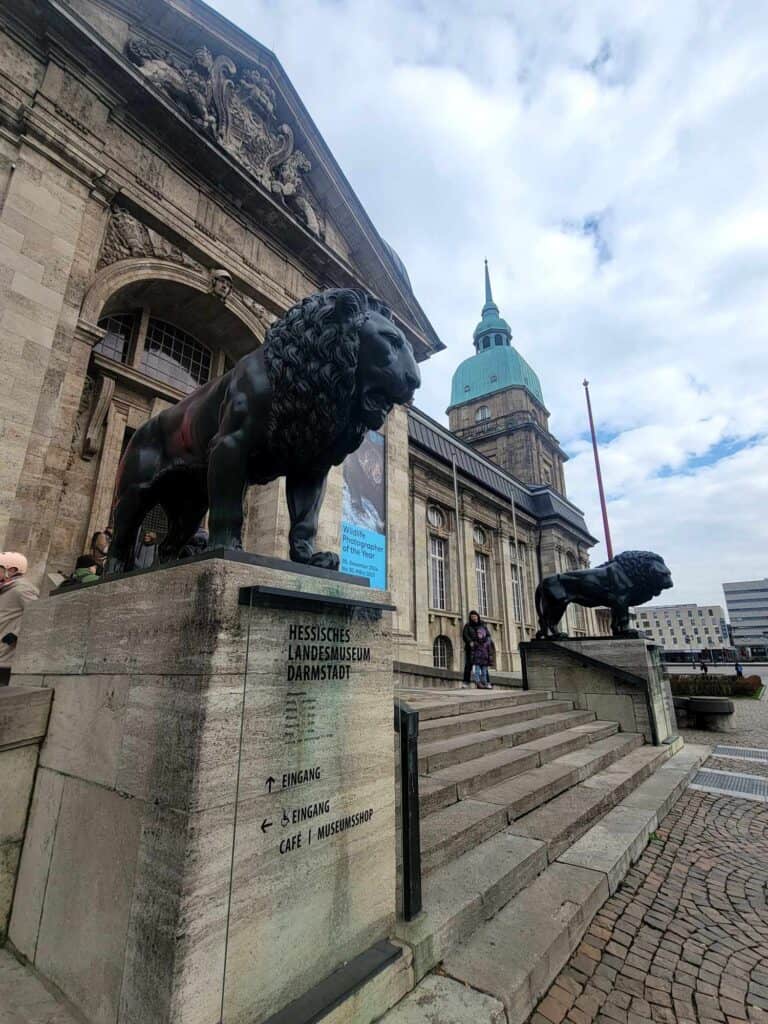
Just a short drive or train ride away in Darmstadt, this grand regional museum is where many of the best fossils from Messel now reside. Plus, there are Ice Age fossils and dinosaurs! It’s the crown jewel for fossil fans!
🔍 What Makes It Special
- Stunning Eocene Hall filled with dozens of Messel specimens
- Full natural history collection including dinosaurs, minerals, and taxidermy
- Fascinating interactive displays
🦴 Iconic Fossils on Display

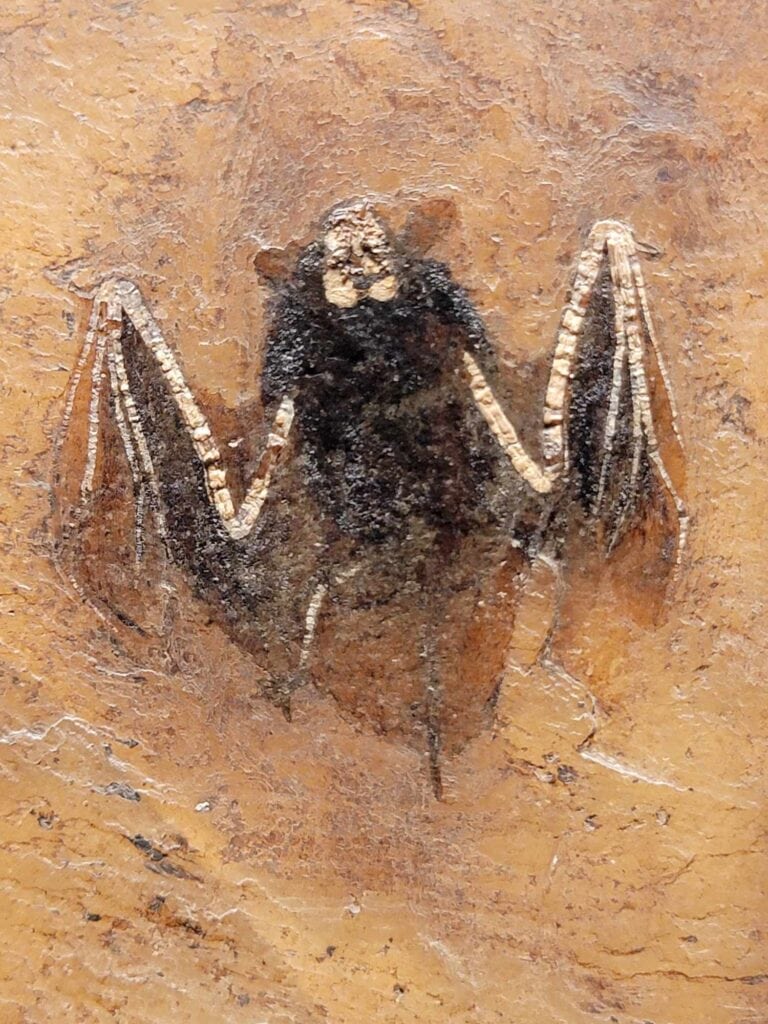

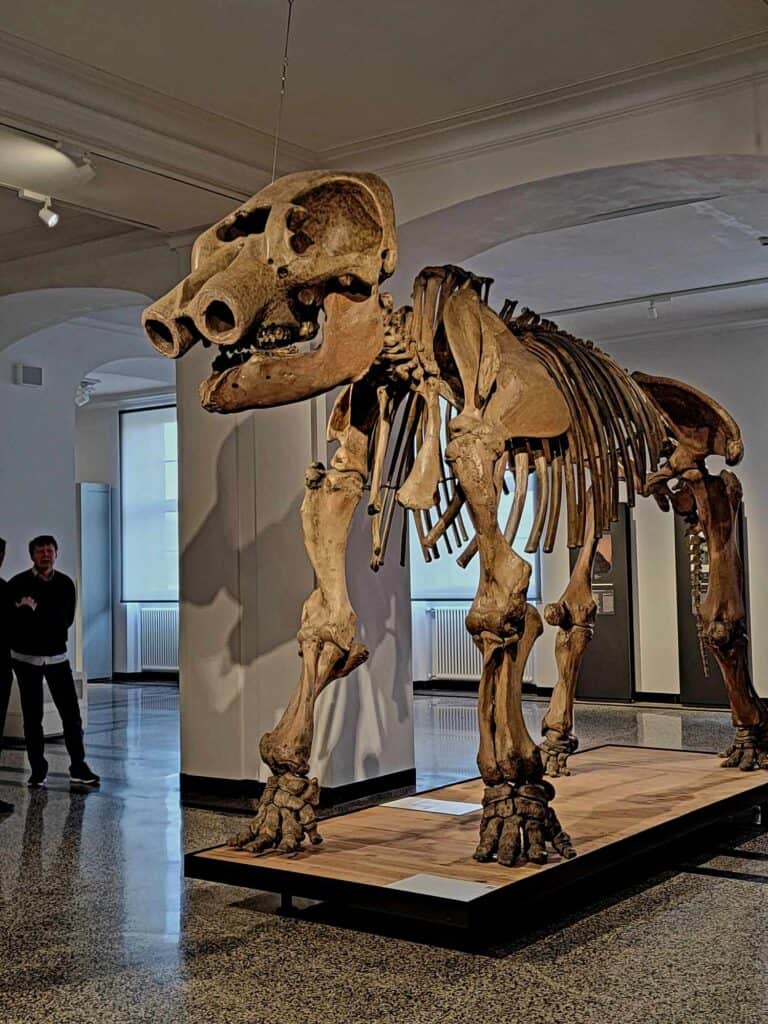
- A hedgehog with fur and spines still visible
- A giant, armor-plated fish predator
- A gigantic bird that looks straight out of Jurassic Park (or should I say Eocene Park!)
- A pair of complete turtles with soft tissue outlines
ℹ️ Visitor Information
- Admission: €6 adults, €4 reduced, free for children under 6
- Hours: Tuesday to Sunday, 10:00 AM to 6:00 PM (closed Mondays)
- Website: hlmd.de
- Parking: There is a large underground parking garage directly in front of the museum
💡 Pro Tip: Allow at least two hours here—this museum is vast and beautifully curated.
⏱ One Day Itinerary to the Messel Fossil Sites
10:00am: Get to the Messel Fossil Pit Visitor Center (Besucherzentrum Grube Messel) when it opens, check out the 15 minute film, and visit the museum displays. Go outside to the viewing platform and look at the pit.
If you take a guided tour, book in advance and allow about an hour for the tour.
11:45am: Visit the Fossilien unt Heimatmuseum in the village of Messel, and view the fossils there.
12:30: Grab a pizza at L’Olivo in Messel (Kohlweg 9, 64409 Messel)! This is authentic Italian-style pizza, and is the best I’ve had in Germany! There’s a huge menu, beer and wine, and the service was fantastic.

After lunch, it’s a short drive into Darmstadt for the grand finale!
1:45: Head to the Hessisches Landesmuseum and spend as much time as you want enjoying the many beautiful natural history displays, medieval artifacts, and art displayed there. The museum closes at 6pm.
5:00: Head down the street to Darmstadter Ratskeller Hausbrauerei, a great German brewery/restaurant and enjoy a sizzling hot schnitzel, some world-class fries, and a beer to end your fabulous fossil day.
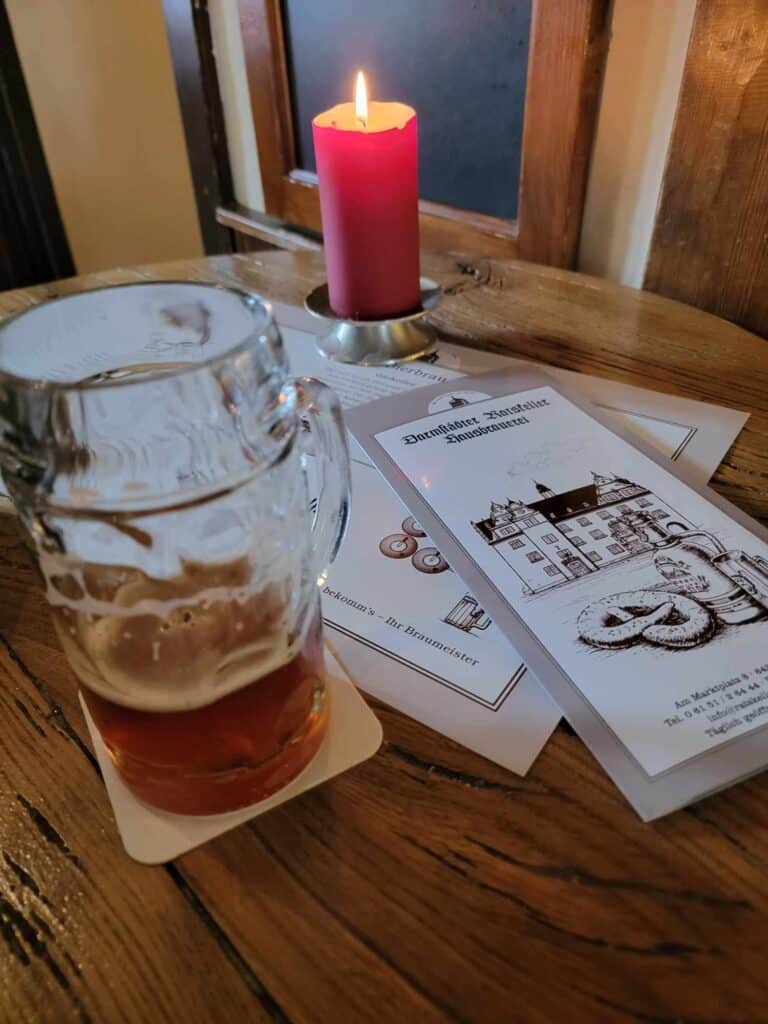
Pro-tip: For a shorter day, you could eliminate the Messel Museum, have lunch at Darmstadter Ratskeller Hausbrauerei instead, then visit the Hessisches Landesmuseum, and call it a day.
🔬 What Are Scientists Still Learning from the Messel Fossil Pit?
Even though it’s been decades since the pit was first protected from becoming a landfill, the Messel Fossil Site is still revealing new information. Scientists continue to excavate, and study to uncover not just new species, but deeper insights into how ancient ecosystems worked. Because the preservation is so detailed, researchers can study what animals ate, how they moved, how they interacted, and even hints about climate change in the Eocene era.
One recent study looked at fossilized pollen and plant matter to reconstruct seasonal patterns, while another analyzed pigment cells in fossilized feathers to predict what colors ancient birds and insects might have been. How cool is that? Pollen fossils aren’t the sexiest, but they help us learn as much as some of the better known species.
Messel fossils are like a big microscope into the ancient world of the Eocene, helping us to understand how life evolved and responded to a warming planet. Sound familiar?
🚗 How to Get to the Messel Fossil Pit
This full-day fossil itinerary is best done by car
- The Messel Fossil Pit is located about 30 minutes southeast of Frankfurt,15 minutes from Darmstadt, and an hour and 15 minutes from Kaiserslautern.
- Directions from Kaiserslautern
- Directions from Frankfurt
- Directions from Darmstadt
- Free parking is available near the Messel Pit Visitor Center (look for “Besucherzentrum Grube Messel” in your GPS).
🐾 Can I Bring My Dog?
- Dogs are allowed on the grounds around the Messel Visitor Center and its nearby trails,but are not permitted inside the fossil pit itself, the indoor exhibitions, the Messel Museum, or the Landesmuseum Darmstadt. So it’s best to leave them home for this trip.
Final Thoughts: Why You Should Definitely Visit the Messel Fossil Pit

Whether you’re a die-hard science nerd like me, part of a family with curious kids, or just someone who appreciates time travel without the flux capacitor, the Messel Fossil Pit offers up something extraordinary. It’s a place where you don’t just learn about prehistory—you feel it. Seeing the delicate bones of a tiny bat, a crocodile having just swallowed its last meal, or a 48-million-year-old leaf with its lacy veins intact is a humbling, awe-inspiring experience.
Best of all, the Messel Fossil story isn’t stuck behind glass. With a guided tour, family-friendly interactive museum displays, and one of Germany’s best natural history collections all within a few kilometers of each other, it will be a day you’ll never forget!
Other posts you may enjoy:
- Dinopark Kaiserslautern: Great Fun for Everyone at Gartenschau!
- 21 Best Things to Do in Kaiserslautern Germany
28 Best Day Trips from Kaiserslautern: Your Ultimate Guide - Best 2 Day Dordogne Prehistory Itinerary: What to See & Do
10 Best Christmas Markets Near Kaiserslautern, Germany - One Day in Bamberg: Best Guide to Germany’s Medieval Beer Capital
- Lowenburg Castle: a Remarkable Medieval Castle that Isn’t!
